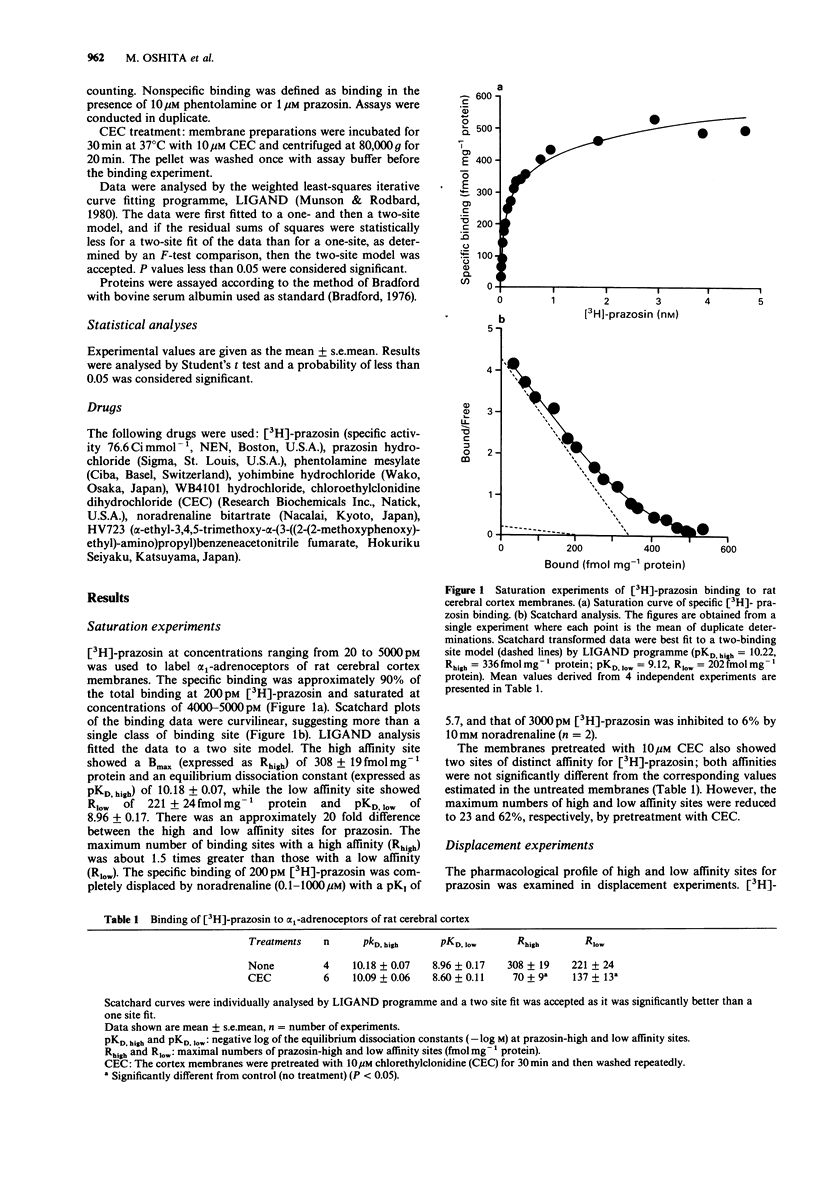Abstract
1. The putative alpha 1-adrenoceptor subtypes of rat cerebral cortex membranes were characterized in binding. 2. Specific binding of [3H]-prazosin was saturable between 20-5000 pm. Scatchard plots of the binding data were non-linear, indicating the presence of two distinct affinity sites for prazosin (pKD, high = 10.18, Rhigh = 308 fmol mg-1 protein; pKD, low = 8.96, Rlow = 221 fmol mg-1 protein). 3. In the membranes pretreated with chlorethylclonidine (CEC) two affinity sites for prazosin were also observed: the affinities were similar to those without CEC pretreatment, but the maximum numbers of binding sites were reduced by CEC pretreatment to 23 and 62% for prazosin-high (Rhigh) and low affinity sites (Rlow), respectively. 4. The prazosin-high affinity sites were further subdivided into two subclasses by WB4101(2-(2,6-dimethoxyphenoxyethyl)aminomethyl-1,4-benzodioxane) and phentolamine; the low affinity sites for WB4101 and phentolamine were more potently inactivated by CEC as compared with the high affinity sites. On the other hand, prazosin, HV723 (alpha-ethyl-3,4,5-trimethoxy-alpha-(3-((2-(2-methoxyphenoxy)ethyl)- amino )-propyl)benzeneacetonitrile fumarate) and yohimbine inhibited [3H]-prazosin binding to prazosin-high affinity sites monophasically. 5. In addition to the high affinity sites, the prazosin-low affinity sites were labelled at high concentrations of [3H]-prazosin. Thus, prazosin and WB4101 showed shallow displacement curves. On the other hand, HV723 and yohimbine did not discriminate between prazosin-high and low affinity sites. 6. Two distinct alpha 1-adrenoceptor subclassifications have been recently proposed (alpha 1A, alpha 1B subtypes and alpha 1H, alpha 1L, alpha 1N subtypes).(ABSTRACT TRUNCATED AT 250 WORDS)
Full text
PDF




Selected References
These references are in PubMed. This may not be the complete list of references from this article.
- Babich M., Pedigo N. W., Butler B. T., Piascik M. T. Heterogeneity of alpha 1 receptors associated with vascular smooth muscle: evidence from functional and ligand binding studies. Life Sci. 1987 Aug 10;41(6):663–673. doi: 10.1016/0024-3205(87)90445-0. [DOI] [PubMed] [Google Scholar]
- Bradford M. M. A rapid and sensitive method for the quantitation of microgram quantities of protein utilizing the principle of protein-dye binding. Anal Biochem. 1976 May 7;72:248–254. doi: 10.1006/abio.1976.9999. [DOI] [PubMed] [Google Scholar]
- Han C., Abel P. W., Minneman K. P. Alpha 1-adrenoceptor subtypes linked to different mechanisms for increasing intracellular Ca2+ in smooth muscle. Nature. 1987 Sep 24;329(6137):333–335. doi: 10.1038/329333a0. [DOI] [PubMed] [Google Scholar]
- Han C., Abel P. W., Minneman K. P. Heterogeneity of alpha 1-adrenergic receptors revealed by chlorethylclonidine. Mol Pharmacol. 1987 Oct;32(4):505–510. [PubMed] [Google Scholar]
- Hanft G., Gross G. Subclassification of alpha 1-adrenoceptor recognition sites by urapidil derivatives and other selective antagonists. Br J Pharmacol. 1989 Jul;97(3):691–700. doi: 10.1111/j.1476-5381.1989.tb12005.x. [DOI] [PMC free article] [PubMed] [Google Scholar]
- Mignot E., Bowersox S. S., Maddaluno J., Dement W., Ciaranello R. Evidence for multiple [3H]prazosin binding sites in canine brain membranes. Brain Res. 1989 May 1;486(1):56–66. doi: 10.1016/0006-8993(89)91277-8. [DOI] [PubMed] [Google Scholar]
- Minneman K. P. Alpha 1-adrenergic receptor subtypes, inositol phosphates, and sources of cell Ca2+. Pharmacol Rev. 1988 Jun;40(2):87–119. [PubMed] [Google Scholar]
- Minneman K. P. Binding properties of alpha-1 adrenergic receptors in rat cerebral cortex: similarity to smooth muscle. J Pharmacol Exp Ther. 1983 Dec;227(3):605–612. [PubMed] [Google Scholar]
- Minneman K. P., Han C., Abel P. W. Comparison of alpha 1-adrenergic receptor subtypes distinguished by chlorethylclonidine and WB 4101. Mol Pharmacol. 1988 May;33(5):509–514. [PubMed] [Google Scholar]
- Molinoff P. B., Wolfe B. B., Weiland G. A. Quantitative analysis of drug-receptor interactions: II. Determination of the properties of receptor subtypes. Life Sci. 1981 Aug 3;29(5):427–443. doi: 10.1016/0024-3205(81)90208-3. [DOI] [PubMed] [Google Scholar]
- Morrow A. L., Creese I. Characterization of alpha 1-adrenergic receptor subtypes in rat brain: a reevaluation of [3H]WB4104 and [3H]prazosin binding. Mol Pharmacol. 1986 Apr;29(4):321–330. [PubMed] [Google Scholar]
- Munson P. J., Rodbard D. Ligand: a versatile computerized approach for characterization of ligand-binding systems. Anal Biochem. 1980 Sep 1;107(1):220–239. doi: 10.1016/0003-2697(80)90515-1. [DOI] [PubMed] [Google Scholar]
- Muramatsu I., Kigoshi S., Oshita M. Two distinct alpha 1-adrenoceptor subtypes involved in noradrenaline contraction of the rabbit thoracic aorta. Br J Pharmacol. 1990 Nov;101(3):662–666. doi: 10.1111/j.1476-5381.1990.tb14137.x. [DOI] [PMC free article] [PubMed] [Google Scholar]
- Muramatsu I., Ohmura T., Kigoshi S., Hashimoto S., Oshita M. Pharmacological subclassification of alpha 1-adrenoceptors in vascular smooth muscle. Br J Pharmacol. 1990 Jan;99(1):197–201. doi: 10.1111/j.1476-5381.1990.tb14678.x. [DOI] [PMC free article] [PubMed] [Google Scholar]
- Oshita M., Iwanaga Y., Hashimoto S., Morikawa K., Muramatsu I. Pharmacological studies on the selectivity of HV-723, a new alpha-1 adrenoceptor antagonist. Jpn J Pharmacol. 1988 Jul;47(3):229–235. doi: 10.1254/jjp.47.229. [DOI] [PubMed] [Google Scholar]
- Piascik M. T., Kusiak J. W., Pitha J., Butler B. T., Le H. T., Babich M. Alkylation of alpha-1 receptors with a chemically reactive analog of prazosin reveals low affinity sites for norepinephrine in rabbit aorta. J Pharmacol Exp Ther. 1988 Sep;246(3):1001–1011. [PubMed] [Google Scholar]
- Tsujimoto G., Tsujimoto A., Suzuki E., Hashimoto K. Glycogen phosphorylase activation by two different alpha 1-adrenergic receptor subtypes: methoxamine selectively stimulates a putative alpha 1-adrenergic receptor subtype (alpha 1a) that couples with Ca2+ influx. Mol Pharmacol. 1989 Jul;36(1):166–176. [PubMed] [Google Scholar]
- Wilson K. M., Minneman K. P. Different pathways of [3H]inositol phosphate formation mediated by alpha 1a- and alpha 1b-adrenergic receptors. J Biol Chem. 1990 Oct 15;265(29):17601–17606. [PubMed] [Google Scholar]


